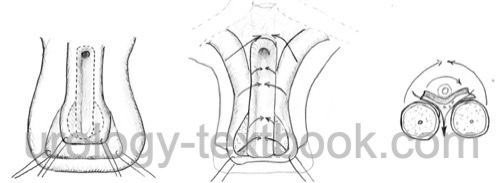You are here: Urology Textbook > Bladder > Exstrophy-epispadias complex
Bladder Exstrophy and Epispadias of the Urethra
Definition of Bladder Exstrophy and Epispadias
The exstrophy-epispadias complex is a severe and rare malformation syndrome of the bladder (exstrophy), the urethra (epispadias), and colon (cloacal exstrophy) with often lifelong consequences (Kiddoo et al., 2004) (Woodhouse et al., 2006).
| Do you want to see the illustration? Please support this website with a Steady membership. In return, you will get access to all images and eliminate the advertisements. Please note: some medical illustrations in urology can be disturbing, shocking, or disgusting for non-specialists. Click here for more information. |
| Do you want to see the illustration? Please support this website with a Steady membership. In return, you will get access to all images and eliminate the advertisements. Please note: some medical illustrations in urology can be disturbing, shocking, or disgusting for non-specialists. Click here for more information. |
Epidemiology
Incidence 2/100.000, male to female ratio = 3:1.
Pathology of the Exstrophy-Epispadias Complex
There is a high variance in the characteristics of the below-mentioned components of the exstrophy-epispadias complex.
Bladder exstrophy:
Bladder exstrophy is a deficient closure of the lower anterior abdominal wall: the bladder is open anteriorly, and the trigonum of the bladder is visible. The posterior bladder wall prolapses through the abdominal wall defect. In addition, there is a diastasis of the symphysis with missing contact between the right and left pubic bone (range 2 to 8 cm).
Epispadias:
In boys, the urethra ends in an opening on the dorsum of the penis. In girls, the urethra is usually completely open and runs from the bladder neck to the hymen. Proximal variants of epispadias are associated with urinary incontinence due to defects of the sphincter muscle.
Cloacal exstrophy:
Cloacal exstrophy is a malformation with missing closure of the ventral colon wall; there is an opening in the proximal direction to the ileum and in the distal direction to the anus. Hemibladders with one ureteral orifice are located right and left of the open colon.
Associated anomalies:
Deformities of the spine and pelvis, hip dysplasia, abnormalities of the upper urinary tract, uterine malformations, hernia, and abnormalities of the heart.
Etiology of Bladder Exstrophy and Epispadias
The missing ingrowth of mesoderm in the cloacal membrane prevents the development of the anterior abdominal wall. The fragile cloacal membrane ruptures in the course of embryonic development. The stage of development at the time of the rupture determines the extent of the malformation: bladder exstrophy, epispadias, and cloacal exstrophy. Other mechanisms or alternative explanations are abnormal developments of the genital tubercle, pelvic bone, or lateral body wall folds.
Treatment of the Exstrophy-Epispadias Complex
Early management after birth:
- Ligate the umbilical cord to avoid the umbilical clamp
- Protect the delicate bladder mucosa with sterile plastic wrap with regular moistening.
- Transfer the child to a center with experience in the surgical treatment of the exstrophy-epispadias complex.
- Clinical examination to estimate the bladder capacity.
- Urogenital imaging: ultrasound of the kidneys, renal scintigraphy, and MRI.
Primary closure of bladder exstrophy:
The estimated bladder capacity should be above 5 ml for a successful primary closure. The surgery is done during the first days of life. It includes the complete mobilization of the bladder plate, preparation of the urethral plate and corpora of the penis, closure of the bladder with bladder neck and proximal urethra, approximation of the symphysis ventral to the bladder neck. Some authors advocate a closure of epispadias in the same session, if good conditions are present.
 |
Closure of epispadias:
The surgical correction of epispadias is usually performed in the 6th to 12th month of life. Phallic enlargement is possible with testosterone treatment. Surgery includes the mobilization and the tubularization of the urethral plate, mobilization and separation of the corpora cavernosa ("penile disassembly technique"), relocation of the neourethra to the ventral of the penis, the reunification of the corpora, and skin closure.
Surgical alternatives for bladders with small capacity:
- Delayed closure (6–12 months after birth) after growth of the bladder template.
- Delayed closure with ileocystoplasty to increase bladder capacity.
- Delayed urinary diversion with a continent stoma.
| Megacystis | Index | Bladder injury |
Index: 1–9 A B C D E F G H I J K L M N O P Q R S T U V W X Y Z
References
Kiddoo u.a. 2004 KIDDOO, D. A. ; CARR, M. C. ;
DULCZAK, S. ; CANNING, D. A.:
Initial management of complex urological disorders: bladder
exstrophy.
In: Urol Clin North Am
31 (2004), Nr. 3, S. 417–26, vii-viii
Woodhouse u.a. 2006 WOODHOUSE, C. R. ; NORTH,
A. C. ; GEARHART, J. P.:
Standing the test of time: long-term outcome of reconstruction of the
exstrophy bladder.
In: World J Urol
(2006)
 Deutsche Version: Harnblasenekstrophie
Deutsche Version: Harnblasenekstrophie